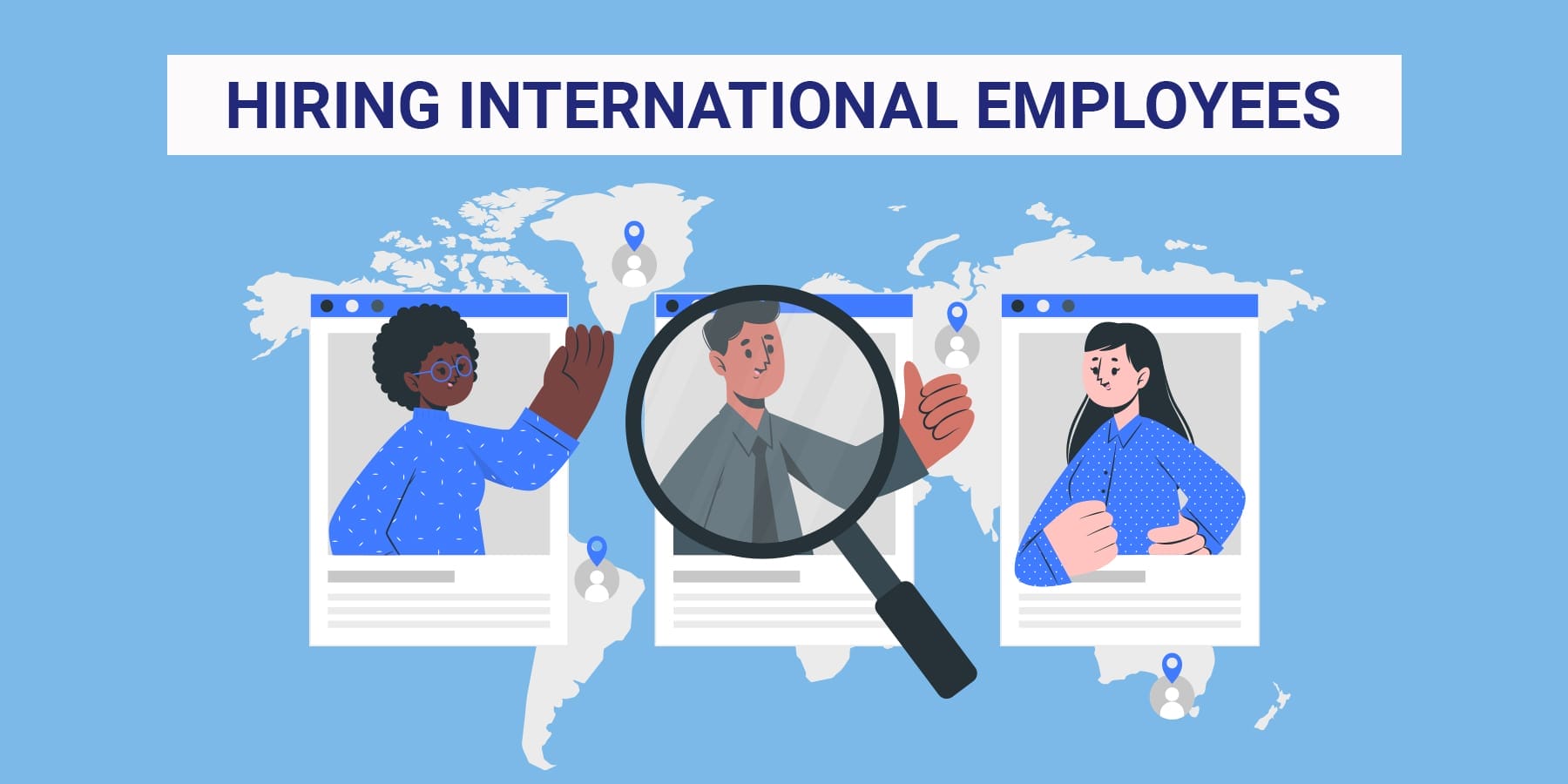Picture this: you’ve spent an entire afternoon dragging images, writing headlines, and tweaking color schemes…

Hiring skilled employees from anywhere in the world feels almost effortless thanks to technology. Yet, employers who want to hire international employees or foreign workers legally and lawfully hire full-time remote workers outside their home country quickly realize the risks, hurdles, and necessity of securing work permits and obtaining relevant certification. Different laws, taxes, and regulatory rules combine into a web of complexity. By 2025, it’s astonishing how many companies still spend thousands opening local companies or branches abroad — only to find it incredibly time-consuming, expensive, and sometimes wholly unnecessary.
There’s genuine frustration: Founders and operations leaders ask why it should be so difficult to legally bring the best international employees and talent on board. The good news is, with the right certification, you no longer have to jump through regulatory hoops or take on unnecessary risk when hiring foreign workers. It’s entirely possible to build a compliant, global team in weeks — often days — without setting up a foreign legal entity.
Let’s break down what makes hiring a global workforce so complex, where traditional methods falter, and how specialized partners like Deel make global hiring safe, fast, and compliant.
TThe Tangle of Global Hiring: Legal and Tax Risks
Hiring foreign workers across borders is more than just a matter of sending a job offer and running payroll through a spreadsheet. If you want to hire international employees legally, you need to navigate a complex web of regulations and compliance requirements.
Labor Laws Change with Borders
Every country has its own approach to employee rights, including employee benefits. These range from minimum wage laws and overtime rules to mandatory benefits and severance payments. What’s routine in California could be illegal in Brazil or highly penalized in France. To hire international employees legally, you must understand and comply with these local labor laws.
“Are They an Employee or a Contractor?”
Misclassifying a worker — accidentally treating a local employee as a contractor without proper certification — remains one of the biggest compliance dangers in international hiring. Many businesses assume that if both sides simply sign a contractor agreement, that’s enough. Unfortunately, local tax authorities see it differently. If you want to hire international employees legally, you must avoid misclassification, as a misclassified contractor (really an employee in the eyes of their country’s laws) can trigger:
- Retroactive tax liabilities
- Heavy fines and penalties
- Mandatory benefit payments
- Risk of litigation or even being banned from the local market
Payroll and Withholding
Each country handles taxes — employee contributions, payroll taxes, social security, healthcare — in unique ways. Non-compliance, even for a single pay period, can spark legal issues for both employer and worker.
Risks of Outsourcing & Contractor Models
Old-school outsourcing firms or loose contractor arrangements might seem tempting but rarely solve the compliance puzzle. Freelance contracts can quickly cross legal boundaries into de facto employment territory, especially as work relationships go from project-based to ongoing, integrated roles.
Here’s a quick comparison:
| Approach | Pros | Cons |
|---|---|---|
| Direct Entity Setup | Full control | Expensive, slow, ongoing admin burden |
| Freelance/Contractor Model | Fast, low-overhead | High misclassification risk, lack of stability |
| Outsourcing Agencies | Less admin work | Quality, transparency, misalignment of incentives |
| EOR (Employer of Record) | Fast, compliant, flexible | Slightly higher monthly cost but far less legal exposure |
How Does an Employer of Record (EOR) Work?
Rather than register a branch or local company, it’s possible to employ talent through an employer of record (EOR). An EOR is a legal entity that acts as the official employer of your overseas staff. While your team reports to you, the EOR manages the legal infrastructure.
- You recruit and select your candidate.
- The EOR (for example, Deel) legally employs them in their country, respecting local labor, immigration, visa, and tax laws.
- The EOR handles hiring, contracts, global payroll, benefits, compliance, and certification — all the messy backend details.
- You pay the EOR a single monthly invoice, and your team is onboarded, protected, and paid on time.
With companies like Deel, which operates in more than 100 countries, the promise is straightforward: you get compliant international hiring, without running afoul of authorities or accidentally breaking employment law.
What Does This Look Like in Practice?
Let’s look at a few typical scenarios that show the practical value of using an EOR like Deel.
US Startup, Eastern European Designer
A San Francisco-based SaaS startup spots a gifted product designer in Warsaw. Rather than subjecting HR to months of learning Polish labor codes or registering a branch, they use Deel as an EOR. The designer receives an ironclad local contract, benefits, and timely pay — all fully compliant. The company gets its new hire started within a week.
UK SaaS, LATAM Support Team
A growing UK software vendor wants Spanish-speaking support but doesn’t want a permanent presence in Colombia or Mexico. Deel allows them to onboard five support reps legally, pay them in local currencies, and ensure proper contributions and withholding. No in-house legal team required.
Solo Founder, Global Micro-Team
An Australian founder builds a remote-first SaaS firm with international employees, including a developer in Vietnam, marketer in Germany, and customer success rep in Kenya, employing foreign workers seamlessly through the EOR. Instead of drowning in paperwork, each employee is formally hired through Deel. The founder runs payroll, manages contracts, and tracks compliance with a single dashboard.
Key Benefits of Using Deel to Hire International Employees Legally
Once you start using an EOR platform, it quickly becomes clear why DIY company setups have become obsolete for most remote teams looking to hire international employees legally.
Fully Compliant Contracts
Deel ensures every employee contract matches the legal requirements of each country, providing certification of compliance for every agreement. These aren’t boilerplate templates — they’re tailored by in-country legal experts to defend against risk, especially when employing foreign workers. This is essential if you want to hire international employees legally and avoid costly compliance mistakes.
Stress-Free Payroll
With Deel, payroll, taxes, bonuses, reimbursements, certification, and employee benefits are handled from the same platform. Payments reach employees in their preferred currency automatically, making it much easier to hire international employees legally without worrying about local payroll complexities.
Local Tax Compliance
Deel manages all legally mandated deductions, social contributions, and certification of employee benefits, including those for foreign workers. Both employer and employee are protected from regulatory surprises, which is a critical part of hiring international employees legally.
Rapid Onboarding
What used to take months (the entity registration process can last up to a year) now takes days. Deel’s onboarding is straightforward, user-friendly, and scalable for teams of any size, featuring comprehensive certification processes that ensure you hire international employees legally and remain compliant with local and international regulations.
Simplified Management and Integrations
A global dashboard gives HR and operations a real-time view of every international employee and foreign workers, ensuring smooth integration and management of international employees across various regions. Deel’s integrations connect seamlessly with best-in-class HR software for 2025, as well as major payroll, accounting, and time-tracking systems.
For enterprise-scale operations, check out best HR software for large organizations to see how certification in global hiring can fit your broader stack.
It can be tempting to treat remote international hires as contractors, especially for early-stage companies. But if your goal is to hire international employees legally, this path can lead to risky territory.
Real Risks with “Easy” Contractor Models
- Local laws trump your contract: No matter what both parties sign, local authorities decide if the worker is really a contractor or an employee.
- No benefits or protections: Contractors don’t get paid leave, sick days, or salary guarantees. Retention and morale suffer.
- No long-term security: Contractors can quit anytime, and you have little recourse.
- Preventing misclassification: Compliance headaches, audit risk, and reputational damage are real concerns.
Adding benefits or ongoing admin support to contractors can easily push the relationship into “employee” territory, especially as work becomes more integral and ongoing. If you want to hire international employees legally, it’s essential to use the right structures and avoid misclassification risks that can jeopardize your business.
Practical Steps for 2025: Make Global Hiring Legally Simple
- Assess your team’s goals: Are you building a product, scaling customer service, or launching new markets?
- Map your target geographies: Where are your best candidates located?
- Evaluate your compliance appetite: Do you have the in-house expertise (and appetite) to manage international contracts, taxes, and labor law?
- Compare providers: Review EOR partners by coverage, support, software integrations, and pricing. Deel stands out for its speed, compliance, and country coverage.
- Onboard quickly and legally: Once you select a partner, you can make a compliant international hire in days, not months.
This approach frees your time and focus for what matters: building a high-performing, happy, and diverse remote team without the risk.
To see how this can work for your organization, try Deel or talk to a global HR advisor before making your next international hire. Secure the talent your business needs — without borders.
Subscribe To Get Update Latest Blog Post
No Credit Card Required









Leave Your Comment: